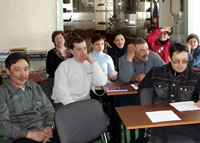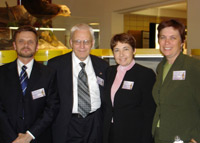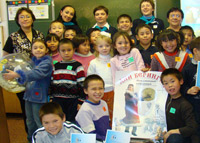Park “Beringia” is a state-run institution concerned with protecting the unique environmental and cultural resources in the Bering Strait region. The Park’s lands and adjacent waters are home to a number of important archaeological sites and natural complexes. Today, “Beringia’s” multi-faceted resources are being utilized for education, research work, tourism, as well as the recreational, spiritual, and subsistence needs of the local people.
The idea of creating an international park in the region of the Bering Strait was first proposed in the 1960s. From the beginning, the Park’s vision acknowledged that spiritual values and ways of life of the indigenous Chukchi and Yupik Eskimo people work hand-in-hand with the goals of biodiversity and ecosystem conservation.
In June 1990 Mikhail Gorbachev and George H.W. Bush signed a joint declaration on the establishment of the Soviet-American Park in the area surrounding the Bering Strait. The declaration states that, in creating this park, both USA and USSR recognize the global significance of the Bering Strait region and take on the shared responsibility to preserve it for the common good. On January 27, 1993, the Nature-ethnic Park “Beringia” was established on the Soviet/Russian side of the Bering Strait. Since then, parts of the Chukchi Peninsula laying within the Park’s territory have been officially designated as nature preserves. The Park’s mission is to sustain and promote the unique indigenous Yupik and Chukchi economies, such as reindeer herding and sea-mammal hunting, within the wider framework of cultural and biological conservation.
 Biologist Nikolai Zheleznev served as the Park’s first director until 2003 and was succeeded by historian Boris Vdovin. Nataliya Kalyuzhina, whose background is in philology and education, has been the Park director since 2006. In 2004 “Beringia” headquarters were relocated from Anadyr to Provideniya. “Beringia” staff operates in Chukotskii and Provideniskii administrative districts, both partly enclosed within the Park lands.
Biologist Nikolai Zheleznev served as the Park’s first director until 2003 and was succeeded by historian Boris Vdovin. Nataliya Kalyuzhina, whose background is in philology and education, has been the Park director since 2006. In 2004 “Beringia” headquarters were relocated from Anadyr to Provideniya. “Beringia” staff operates in Chukotskii and Provideniskii administrative districts, both partly enclosed within the Park lands.
The organizational structure of the Nature-ethnic Park “Beringia” consists of the central office in Provideniya, Chukotsky and Providensky district branches, and inspectors who observe a total of 11 areas. The majority of inspectors are either Yupik or Chukchi natives, with age ranging from upper 20s to mid-60s, which provides for a wide diversity of perspectives and skills utilized in gathering information about the Park. The Director and other staff take advantage of any opportunity to visit the Park’s most remote – from the central headquarters – regions, such as the settlement of Enurmino located on the north coast of the of the Chukchi Peninsula. Training seminars, which allow the Park management and inspectors to lean from one another through a series of workshops and discussions, take place annually. The Department of Industry and Agricultural Policy of the Chukotskii Autonomous District is the entity responsible for overseeing all activities connected with the Park.
 The observations of cultural and ecological processes taking place in the Park are recorded in the inspectors’ field diaries, which now span over 15 years. We also maintain a photo archive of Park landscapes, wildlife, archaeological objects, and cultural events. In addition to car, the transportation modes utilized to conduct observations in the Park include boat, snow machine, and dog team.
The observations of cultural and ecological processes taking place in the Park are recorded in the inspectors’ field diaries, which now span over 15 years. We also maintain a photo archive of Park landscapes, wildlife, archaeological objects, and cultural events. In addition to car, the transportation modes utilized to conduct observations in the Park include boat, snow machine, and dog team.
We collaborate with a number of research institutions, organizations, and scientists based in Russia and overseas. Since 2001, Park representatives have been participating in the annual international conference “Beringia Days.” The conference site alternates between the Russian and American sides of the Bering Strait. We also cooperate with the National Park Service of the United States within the framework of the Shared Beringian Heritage Program. The Museum of Beringian Heritage in Provideniya has been our working partner for many years. Among the archaeological works carried out in the Park are those near the old settlement of Kivak organized by Dr. Aleksandr Orekhov, and Dr. Konstantin Dneprovsky near the mouth of the Chegitun River.
 To share our findings and inform local communities of our activities, we regularly contribute articles to local newspapers, give presentations in schools, and hold public meetings in villages. One of our inspectors specializes in ecological education and is regularly working with children, who then take part in various contests organized by the Federal program “March of Parks” within the Center for Nature Preservation. As one its tasks, the Beringia Park supports the initiatives to develop resources necessary for ecological tourism.
To share our findings and inform local communities of our activities, we regularly contribute articles to local newspapers, give presentations in schools, and hold public meetings in villages. One of our inspectors specializes in ecological education and is regularly working with children, who then take part in various contests organized by the Federal program “March of Parks” within the Center for Nature Preservation. As one its tasks, the Beringia Park supports the initiatives to develop resources necessary for ecological tourism.
As noted by the Park’s former director Boris Vdovin, “the nature and cultural heritage of Eastern Chukotka must have a higher protection status” (2003). On the eve of its 15th anniversary “Beringia” is on its way to becoming a Federal National Park. Future “Beringia” will take up adequate place among other national parks in working towards nature conservancy, scientific research, ecological education, and preservation of cultural resources. The history and accomplishments of the regional park will provide a firm foundation for this agenda.
